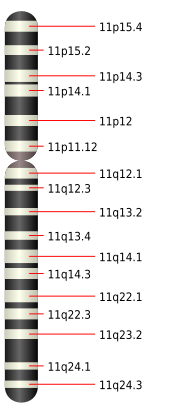Potocki-Shaffer Syndrome
| Classification according to ICD-10 | |
|---|---|
| Q93 | Autosome monosomies and deletions, not elsewhere classified |
| Q93.5 | Other deletions of a part of a chromosome |
| ICD-10 online (WHO version 2019) | |
The Potocki-Shaffer syndrome ( English Potocki-Shaffer syndrome ) is a very rare genetically caused syndrome in humans that causes various changes in the skeletal system . The cause is a chromosome mutation with deletion of several neighboring genes in section 11p11.2 on chromosome 11 .
Synonyms in the Anglo-American literature are chromosome 11p11.2 deletion syndrome , P11pDS and proximal 11p deletion syndrome .
The disorder as a syndrome was first described in 1996 by L. Potocki and LG Shaffer.
distribution
The frequency ( prevalence ) of the syndrome is given as less than 1: 1,000,000.
By 2006, 23 patients from 14 families had been described. As of October 2012, fewer than 100 cases had been reported.
root cause
Emergence
The majority of cases are caused by a deletion of the chromosome segment during the formation of the parental gametes , i.e. sperm or egg cells , or during the early fetal development of the child. It is less common for the person affected to inherit the disorder from a parent. In these cases the disorder follows an autosomal dominant inheritance .
Affected genes
Potocki-Shaffer syndrome is caused by deletion of part of chromosome 11 . On its short arm, proximally (close to the centromere ) is the area 11p11.2 , on which various genes are arranged:
- EXT2 : The loss of this gene causes numerous exostoses . The EXT2 codes for a protein called exostosin-2 , which in turn binds to exostosin-1 in the Golgi apparatus . The complex of exostosin-1 and exostosin-2 influences the formation of heparan sulfate , which is involved in numerous processes in the body.
- ALX4 : The loss of this gene is responsible for the enlarged fontanelles . ALX4 codes for a transcription factor that appears to be important for the normal development of the skull.
- PHF21A codes for BHC80 which, together with BRAF35 and a histone deacetylase, forms the corepressor complex BHC , which in turn is involved in the gene regulation of certain genes for nerve cells .
Presumably, other genes in the same chromosome segment are involved in Potocki-Shaffer syndrome.
Clinical phenomena
The Potocki-Shaffer syndrome is characterized by numerous exostoses , parietal foramina (additional openings in the parietal bone ), enlarged anterior fontanels and occasionally reduced intelligence and developmental delays as well as slight craniofacial anomalies ( malformations of the facial skull ), including short-headedness ( brachycephaly ), pronounced nasal ridge , Shortened distance between nose and mouth (narrow philtrum ), drooping corners of the mouth.
Sometimes there is also a permagna parietal foramina .
The rare symptoms of the syndrome include impaired vision and malformations of the heart , kidneys and other urinary organs .
Very rarely, the exostoses can degenerate into malignant disease, i.e. develop into cancer .
Examination methods and treatment
Diagnosis is clinical (based on symptoms ). The genetic disorder is detected cytogenetically (by means of fluorescence in situ hybridization , FISH test ) or molecular genetic . Occasionally, it is recommended that the parents of an affected child be screened for balanced translocations to assess the risk of recurrence in later children.
It is a systematic search for visual disorders such as strabismus (Strabismus) and nystagmus recommended and after hearing disorders.
The therapy is based on the symptoms and includes elements of early intervention . A causal therapy is not known.
Sources and References
Web links
- Potocki-Shaffer syndrome. In: Online Mendelian Inheritance in Man . (English)
- Potocki-Shaffer Syndrome. In: Orphanet (Rare Disease Database).
- Potocki-Shaffer syndrome at Genetics Home Reference (ghr.nlm.nih.gov)
Individual evidence
- ↑ L. Potocki, LG Shaffer: Interstitial deletion of 11 (p11.2p12): a newly described contiguous gene deletion syndrome involving the gene for hereditary multiple exostoses (EXT2). In: American journal of medical genetics. Volume 62, Number 3, March 1996, pp. 319-325, ISSN 0148-7299 . doi : 10.1002 / (SICI) 1096-8628 (19960329) 62: 3 <319 :: AID-AJMG22> 3.0.CO; 2-M . PMID 8882796 . (Review).
- ↑ POTOCKI-SHAFFER SYNDROME. In: Online Mendelian Inheritance in Man . (English)
